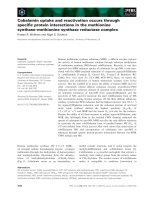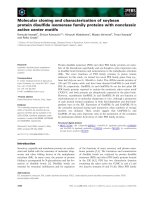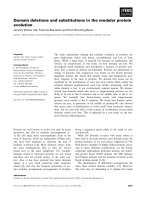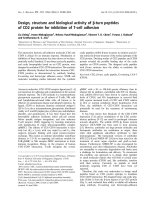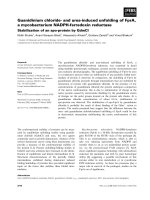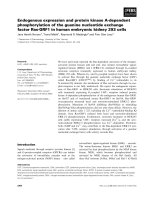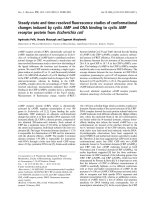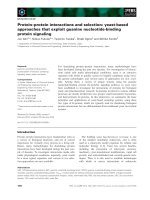Báo cáo khoa học: Protein aggregation and amyloid fibril formation prediction software from primary sequence: towards controlling the formation of bacterial inclusion bodies pot
Bạn đang xem bản rút gọn của tài liệu. Xem và tải ngay bản đầy đủ của tài liệu tại đây (334.47 KB, 8 trang )
MINIREVIEW
Protein aggregation and amyloid fibril formation
prediction software from primary sequence: towards
controlling the formation of bacterial inclusion bodies
Stavros J. Hamodrakas
Department of Cell Biology and Biophysics, Faculty of Biology, University of Athens, Greece
Background and aims
Normally soluble proteins or peptides convert under
certain conditions into ordered fibrillar aggregates
known as amyloid deposits. The fibrils which consti-
tute these amyloid deposits are known as amyloid
fibrils and the amyloid fibrils or their precursors
appear to be related to several neurodegenerative dis-
eases including Alzheimer’s, Parkinson’s, Huntington’s,
and also type II diabetes, prion diseases and many oth-
ers, collectively called amyloidoses. Amyloidogenic
proteins are quite diverse, with little similarity in
sequence and native three-dimensional structure [1,2].
Additionally, several proteins and peptides not related
to amyloidoses have the potential to form amyloid
fibrils in vitro, suggesting that this ability for structural
rearrangement and aggregation may be inherent to
proteins [3].
All amyloid fibrils share the same cross-beta archi-
tecture and several functional proteins found in bacte-
ria, fungi, insects and humans have also been found to
adopt the same architecture under physiological condi-
tions, as part of their functional role ([4–8] and refer-
ences therein), despite the diversity of origin of their
constituent proteins. Attention was given to these func-
tional amyloids after our finding that silkmoth chorion
is a natural protective amyloid [9,10].
Theoretical and experimental evidence indicates that
short sequence stretches may be responsible for amy-
loid formation [11–13] and several methods have been
published recently that attempt to predict aggregation-
prone or amyloidogenic regions, based on various
Keywords
aggregation-prone amino acid stretches;
amyloid-fibril forming regions; amyloidoses;
functional amyloids; prediction software
Correspondence
S. J. Hamodrakas, Department of Cell
Biology and Biophysics, Faculty of Biology,
University of Athens, Panepistimiopolis,
Athens 157 01, Greece
Fax: +30 210 727 4254
Tel: +30 210 727 4931
E-mail:
Website:
(Received 28 January 2011, revised 18 April
2011, accepted 3 May 2011)
doi:10.1111/j.1742-4658.2011.08164.x
Proteins might aggregate into ordered or amorphous structures, utilizing
relatively short sequence stretches, usually organized in b-sheet-like assem-
blies. Here, we attempt to list all available software, developed during the
last decade or so, for the prediction of such aggregation-prone stretches
from protein primary structure, without distinguishing whether these algo-
rithms predict amino acid sequences destined to be involved in ordered
fibrillar amyloids or amorphous aggregates. The results of application of
four of these programs on 23 proteins related to amyloidoses are com-
pared. Because protein aggregation during protein production in bacterial
cell factories has been shown to resemble amyloid formation, the algo-
rithms might become useful tools to improve the solubility of recombinant
proteins and for screening therapeutic approaches against amyloidoses
under conditions that mimic physiologically relevant environments. One
such example is given.
Abbreviations
HST, hot-spot threshold; IB, inclusion body.
2428 FEBS Journal 278 (2011) 2428–2435 ª 2011 The Author Journal compilation ª 2011 FEBS
properties of proteins (tango [14], pasta [15–21],
aggrescan [22], salsa [23,24], zyggregator [25]).
We should perhaps mention here that some of the pre-
diction methods try to distinguish amyloid fibril
(ordered aggregates) prediction from amorphous
aggregate prediction, providing also the relevant physi-
cal reasoning and influencing factors. However, we
shall not attempt to distinguish between the two, obvi-
ously functionally different, cases hereinafter.
This minireview aims to provide (a) a short descrip-
tion of prediction algorithms and available software,
(b) results of their use on a set of 23 well-known amy-
loidogenic proteins and (c) guidance towards applying
this software as a useful tool for improving the solubil-
ity of recombinant proteins and for controlling the for-
mation of bacterial inclusion bodies (IBs).
Short description of prediction
algorithms and available software
Each method makes its own assumptions and imple-
ments its own predictors, which range from quite sim-
plistic to quite complex. The ability to form b-strands
is a predominant feature in most works, either in the
form of statistical propensities or in the form of struc-
tural stability. Yoon and Welsh [15] searched for hid-
den beta-propensity in sequences, in other words
regions that appear to be natively a-helical but have
nonetheless the ability to form b-strands. Hamodrakas
et al. [26] have similarly looked for ‘conformational
switches’ in sequences – regions with a high predicted
tendency to form both a-helices and b-strands – using
the consensus secondary structure prediction program
secstr [27] and Zibaee et al. [24] looked for b-conti-
guity, essentially a derivative of b-strand propensity
based on the Chou and Fasman [28,29] set of second-
ary structure preference values. In a more structural
approach, Thompson et al. [20] and Zhang et al. [23]
identified regions computationally that can be stable
b-strands in a stacked b-sheet crystal, similar to the
one obtained from the peptides GNNQQNY and
NNQQNY [30], known amyloidogenic regions from
the yeast prion Sup35, while Trovato et al. [21]
looked for regions with the ability to pair with each
other and form b-sheets, with their program termed
pasta.
The formation of b-strands is not the only predictor
though. Conchillo-Sole
´
et al. [22] defined a set of
aggregation propensities upon which they calculate the
presence of aggregation ‘hot-spots’ in sequences. Their
aggrescan software is based on an aggregation-pro-
pensity scale for the 20 natural amino acids derived
from in vivo experiments and on the assumption that
short and specific sequence stretches are responsible
for protein aggregation. In some more detail: relative
experimental aggregation propensities, for each of the
20 natural amino acids, were initially derived from the
intracellular aggregation of mutants, performing sin-
gle-point mutations at the central position (19) of the
central hydrophobic cluster comprising residues 17–21
of amyloid Ab
1–42
Alzheimer’s peptide ([22] and refer-
ences therein). Then, a value is assigned to each resi-
due of a given polypeptide sequence, which is taken
from the table giving the relative experimental (in vivo)
aggregation propensities of the 20 natural amino acids
(a3v). Next, calculations are based on the sliding-win-
dow averaging technique: a sliding window of a given
length is chosen and the program calculates the aver-
age of a3v values over the sliding window and assigns
it to the central residue of the window (sliding-window
lengths of 5, 7, 9 and 11 residues were trained against
a database of 57 amyloidogenic proteins in which the
location of aggregation hot-spots was known from
experiment). This average is called a4v [22]. A plot of
a4v over the entire sequence defines the aggregation
profile of the polypeptide. The hot-spot threshold
(HST) was defined as the average of the a3v of the 20
natural amino acids weighted by their frequencies in
the SwissProt database [22]. A segment of the polypep-
tide sequence is considered as a putative aggregation
hot-spot if there are five or more consecutive residues
with an a4v larger than the HST and none of them is
a proline (aggregation breaker). Several other parame-
ters are calculated and reported, such as the average
a4v in each hot-spot, the area of the aggregation pro-
file above the HST, the total area (the HST being the
zero axis) and the area above the HST of each profile
peak identified as a hot-spot. These areas are calcu-
lated numerically using the trapezoidal rule [22]. The
best predictions were obtained utilizing a sliding-win-
dow size of 5 for protein sequences with a length £ 75
residues, 7 for £ 175 residues, 9 for £ 300 residues and
11 for > 300 residues.
Galzitskaya et al. [18,19] also defined a novel intrin-
sic property for amino acid residues, the average
expected packing density, which they found to be cor-
related to amyloidogenesis, while Lo
´
pez de la Paz and
Serrano [11] identified a sequence pattern that is
involved in the formation of amyloid-like fibrils.
A variety of multi-parametric methods exist as well.
Pawar et al. [17] and Tartaglia et al. [25] combine
intrinsic properties of amino acid sequences to calcu-
late aggregation propensities, while Tartaglia et al. [25]
and Fernandez-Escamilla et al. [14] additionally
include the effect of environmental variables in their
equations for calculating aggregation rates.
S. J. Hamodrakas Software for controlling formation of bacterial inclusion bodies
FEBS Journal 278 (2011) 2428–2435 ª 2011 The Author Journal compilation ª 2011 FEBS 2429
We demonstrated that a consensus approach might
be better suited for the task of predicting amyloido-
genic stretches [26] and we developed a consensus algo-
rithm, amylpred [31], which combines some of these
methods, representing most of the above-mentioned
categories. These amyloidogenic determinants may
often act as ‘conformational switches’ and thus they
may play the role of templates initiating amyloid for-
mation, through perhaps local structural rearrange-
ments. We have shown that this tool successfully
predicts nearly all experimentally verified amyloido-
genic determinants in the sequences of proteins causing
amyloidoses. Furthermore, amylpred predicts on the
sequences of amyloidogenic proteins several short
potential amyloidogenic stretches that have not yet
been experimentally verified [31]. A rather important
finding by the application of this tool is that nearly all
experimentally verified amyloidogenic determinants or
aggregation-prone sequences and most predicted but
not yet experimentally verified amyloidogenic regions
reside on the surface of the crystallographically solved
crystal structures of the relevant amyloidogenic pro-
teins. This is shown in Figs 1 and 2 and, in more
detail, in [31].
Several other methods have also been proposed
recently that attempt to predict aggregation-prone or
amyloidogenic regions in protein sequences. Clarke
and Parker [32] combined a coarse-grained physico-
chemical protein model with a highly efficient Monte
Carlo sampling technique to identify amyloidogenic
sequences in four proteins for which respective experi-
mental peptide fragmentation data exist. Peptide
sequences were defined as amyloidogenic if the ensem-
ble structure predicted for three interacting peptides
described a stable and regular three-stranded b-sheet.
Tian et al. [33] proposed a method, named pafig (pre-
diction of amyloid fibril forming segments) based on
support vector machines, to identify hexapeptides asso-
ciated with amyloid fibrillar aggregates. pafig was used
to predict the potential fibril-forming hexapeptides in
all of the 64 000 000 possible hexapeptides. As a result,
approximately 5.08% of hexapeptides showed a high
aggregation propensity.
netcssp, an algorithm developed by Kim et al. [34],
implements the latest version of the cssp algorithm
and provides a Flash-chart-based graphic interface that
enables an interactive calculation of CSSP values for
any user-selected regions in a given protein sequence.
The cssp algorithm (calculation of contact-dependent
secondary structure propensity) is a sensitive method
that detects non-native secondary structure propensi-
ties in protein primary structures. The method predicts
local conformational changes, usually associated with
protein aggregation and amyloid fibril formation, and
can quantitatively estimate the mutational effect on
changes in native or non-native secondary structural
propensities in local sequences. This web tool provides
pre-calculated non-native secondary structure propen-
sities for over 1 400 000 fragments that are seven resi-
dues long, collected from Protein Data Bank (PDB)
structures. They are searchable for chameleon subse-
quences (sequences that have the ability to form both
a-helix and b-sheet) that can serve as the nucleating
core of amyloid fibril formation.
The algorithm betascan [35] calculates likelihood
scores for potential b-strands and strand-pairs based
Fig. 1. Cartoon representations of seven proteins related to amyloi-
doses, with experimentally determined structures, which contain
experimentally determined amyloidogenic regions. These seven
protein models (see also Table S1), which were produced utilizing
PYMOL [42] are (A) prolactin (PDB 1RWS); (B) apolipoprotein A-I
(2A01); (C) transthyretin (1BMZ); (D) lactoferrin (1CB6); (E) lyso-
zyme C (1LZ1); (F) gelsolin (2FGH); (G) b
2
-microglobulin (1LDS).
Experimentally determined amyloidogenic regions are shown in yel-
low. Theoretically predicted amyloidogenic regions, utilizing
AMYL-
PRED
[31], which coincide with experimentally determined regions
are coloured red, whereas predicted amyloidogenic regions by
AM-
YLPRED
are shown in blue. The remainder of each protein is shown
in green. Adapted from [31] with permission of BiomedCentral Ltd.
Software for controlling formation of bacterial inclusion bodies S. J. Hamodrakas
2430 FEBS Journal 278 (2011) 2428–2435 ª 2011 The Author Journal compilation ª 2011 FEBS
on correlations observed in parallel b-sheets. The pro-
gram then determines the strands and pairs with the
greatest local likelihood for all of the sequence’s poten-
tial b-structures. betascan suggests multiple alterna-
tive folding patterns and assigns relative a priori
probabilities based solely on amino acid sequence,
probability tables and pre-chosen parameters.
In the foldamyloid method [36], which is an exten-
sion of a method published by the same authors
[18,19] based on the expected packing density of
residues, two characteristics (expected probability of
hydrogen bond formation and expected packing den-
sity of residues) are simultaneously used to detect amy-
loidogenic regions in a protein sequence. The authors
claim that regions with high expected probability of
formation of backbone–backbone hydrogen bonds as
well as regions with high expected packing density are
mostly responsible for the formation of amyloid fibrils.
In more detail, the observed packing density for each
amino acid residue was calculated from a database of
3769 three-dimensional protein structures (which have
< 25% sequence identity between each other)
obtained from the SCOP database [37], containing pro-
teins which belong to the four main SCOP classes
(classes a, b, c and d, which are all-a, all-b, a ⁄ b and
a + b proteins, respectively) [36]. The observed pack-
ing density for each amino acid residue is defined as
the number of amino acid residues in contact with the
given residue (two residues are considered to be in con-
tact if any pair of their non-hydrogen atoms is at a
distance < 8A
˚
). Neighbouring residues in the amino
acid sequence were excluded from this consideration.
The calculated values (average observed packing den-
sity values for each amino acid residue, for the entire
database) are used as a prototype scale for construct-
ing a packing density profile for a certain protein
sequence. Calculations are based on the sliding-win-
dow averaging technique. First, an expected value is
assigned to each residue of the protein, equal to the
average packing density value observed for this type of
residue; then, the obtained values are averaged inside
the window and the average is assigned to the central
residue of the window. The ‘smoothed’ expected values
for every position of the polypeptide chain provide the
final profile, which is directly used for the prediction
of amyloidogenic regions. On the ‘smoothed’ profile, a
region is predicted as an amyloidogenic one if all its
residues lie above a given cut-off (have numbers of
expected contacts higher than the cut-off) and the size
of the region is greater than or equal to the size of the
sliding window used. Optimum values for the cut-off
(threshold) and the sliding-window length are 21.4 con-
tacts per residue and five residues, respectively [36].
The authors of foldamyloid also constructed two
separate, different probability scales for the 20 amino
acid residue types, acting separately either as donors
or acceptors of backbone–backbone hydrogen bonds,
calculated from the same database of 3769 proteins,
utilizing the dssp program [38]. The probability of
backbone–backbone hydrogen bond formation, for
each residue type, was calculated separately as the
total number of hydrogen bonds this residue forms,
acting either as donor or as acceptor, respectively,
divided by the total number of residues of the same
type in the database. The two, apparently, separate
scales of probability of hydrogen bond formation are
also used for constructing profiles over a protein
sequence. Similarly as above, for the construction of
Fig. 2. Cartoon representations of five proteins related to amyloi-
doses, with experimentally determined structures which do not
contain experimentally determined amyloidogenic regions. These
five protein models (see also Table S1), which were produced utiliz-
ing
PYMOL [42] are (A) immunoglobulin j-4 light chain (PDB 1LVE);
(B) superoxide dismutase (2C9V); (C) immunoglobulin G1 heavy
chain (1HZH); (D) insulin (1ZNJ); (E) cystatin C (1R4C). Predicted
amyloidogenic regions by
AMYLPRED [31] are shown in blue (see also
Table S1). The remainder of each protein is shown in green.
Adapted from [31] with permission of BiomedCentral Ltd.
S. J. Hamodrakas Software for controlling formation of bacterial inclusion bodies
FEBS Journal 278 (2011) 2428–2435 ª 2011 The Author Journal compilation ª 2011 FEBS 2431
the profiles calculations are based on the sliding-win-
dow (five residues in length) averaging technique. First,
an expected value is assigned to each residue of the
protein, equal to the probability of backbone–back-
bone hydrogen bond formation observed for this type
of residue; then, the obtained values are averaged
inside the window and the average is assigned to the
central residue of the window. The smoothed expected
values for every position of the polypeptide chain pro-
vide the final profile, which is directly used for the pre-
diction of amyloidogenic regions. On the smoothed
profile, a region is predicted as an amyloidogenic one
if all its residues lie above a given cut-off and the size
of the region is greater than or equal to the size of the
sliding window used. Optimum values for the cut-offs
(thresholds), determined from receiver–operator char-
acteristic curves, are 0.697 for the method based on
the donor scale and 0.671 for the method based on the
acceptor scale [36].
Thus, there are three scales which allow the predic-
tion of amyloidogenic regions in a protein sequence
(or rather, the ability of a peptide to be amyloido-
genic): the scale of the packing density, and two scales
of the probability of formation of backbone–backbone
hydrogen bonds (assigned to donor and to acceptor
residues, termed donor and acceptor scales, respec-
tively). The authors, in order to take into consider-
ation the above-mentioned scales simultaneously, have
constructed several ‘hybrid’ scales by merging the indi-
vidual scales with equal weights. The ‘hybrid’ scale,
which includes all three scales (contacts +
donors + acceptors) with equal weights, correctly pre-
dicts 80% of amyloidogenic peptides (115 of 144 pep-
tides) and 72% of non-amyloidogenic ones (189 of 263
peptides), with a cut-off value of 0.062, from a data-
base of 407 amyloidogenic and non-amyloidogenic
peptides provided at the foldamyloid site (Table 1)
[36].
waltz is a web-based tool that uses, mainly, a posi-
tion-specific scoring matrix (PSSM) to determine amy-
loid-forming sequences [39]. The PSSM was built
based on the experimental exploration of the sequence
space of amyloid hexapeptides. According to its
authors, waltz allows for identification and better dis-
tinction between amyloid sequences and amorphous
b-sheet aggregates, and also allows for identification of
amyloid-forming regions in functional amyloids. In
more detail, the waltz algorithm was developed by
combining specific sequence information with physico-
chemical as well as structural information.
The PSSM for amyloid propensity of waltz, was
constructed from an experimentally defined training set
comprising 116 ‘positive’ (amyloid-forming) hexapep-
tides and 162 ‘negative’ (non-forming) hexapeptides
( This data set is an exten-
sion of the AmylHex database, which contains
community-generated, experimentally verified amyloi-
dogenic hexapeptides, consisting of 67 ‘positive’ and 91
‘negative’ examples that have been used to benchmark
novel prediction methods [20]. The additional exam-
ples ⁄ hexapeptides were identified experimentally by the
authors of waltz [39]. The position-specific score for
an amino acid was calculated as a standard log-odd
score in a position-specific scoring matrix (the value
for each amino acid at each position is the logarithm
of the ratio of its frequency in the training set and the
background database). As there is a positive and a
negative set that both sample well the amino acid
space over the motif (hexapeptide) positions, one pro-
file was created for each set (positive and negative,
respectively) and the score against the negative profile
is subtracted (compliance with the negative set) from
the score against the positive profile. Apparently, the
sequence profile (S
profile
) is the sum of position-specific
scores for all amino acids in the hexapeptide.
Nineteen selected physical properties which best
describe amyloid propensity enter the scoring function
as a physical property term S
physprop
consisting of the
sum of the products of the amino acid frequency with
the normalized property value of the respective amino
acid for each position. Essentially, these properties
can be assigned to three major groups representing
beta, helical and solvation-related hydrophobicity pro-
pensities.
As the analysis of the hexapeptide experimental data
sets (positive and negative) may impose sequence bias
specific to the available data, the authors of waltz
Table 1. Protein aggregation and amyloid fibril formation prediction
servers (URLs) and software.
Method URL or software
TANGO [14] />PASTA [21] />AGGRESCAN [22] />PRE-AMYL [23] Available at />pub/software/pre-amyl/
SALSA [24] To obtain the software, contact
Louise Serpell ()
ZYGGREGATOR [25] />zyggregator_test.php
AMYLPRED [31] />PAFIG [33] Available at />NETCSSP [34] />BETASCAN [35] />FOLDAMYLOID [36] />WALTZ [39] />Software for controlling formation of bacterial inclusion bodies S. J. Hamodrakas
2432 FEBS Journal 278 (2011) 2428–2435 ª 2011 The Author Journal compilation ª 2011 FEBS
estimated the preference or non-preference of amino
acids at the hexapeptide motif positions on a structural
basis using the atomic force field foldx. The fibril
crystal structure of the GNNQQNY peptide from
Sup35 (PDB 1YJP) was first simplified to polyalanine.
Then, all possible pair combinations of all 20 natural
amino acids at all positions were generated and
energy-optimized using foldx [40]. Energy estimates
were calculated with foldx as the DG difference
(DDG) to the reference polyalanine. To retrieve a posi-
tion-specific pseudoenergy matrix for the prediction
scoring function (and calculate S
struct
), they averaged
for each amino acid the energies for all its occurrences
at a certain position in combination with all amino
acids at other positions [39]. waltz combines
sequence, physicochemical as well as structural infor-
mation into a composite scoring function:
S
total
= S
profile
+ S
physprop
) 0.2S
struct
.
The authors of waltz claim that, when omitting the
physicochemical property and structural descriptors in
the prediction function, the sequence profile alone per-
forms better than other prediction algorithms,
although less than the complete scoring function. For
more details, an interested reader should consult the
original publication.
Table 1 provides a list of available servers and also
sites for downloading available software developed for
protein aggregation ⁄ amyloid fibril formation predic-
tion.
Conclusions
Table S1 contains the results of the application of four
(amylpred [31], aggrescan [22], waltz [39] and
foldamyloid [23]) of these servers on 23 well-known
amyloidogenic proteins [31]. Three of these methods,
aggrescan, foldamyloid and waltz, were analysed
in more detail above. A comparison of ‘aggregation-
prone’ stretches ⁄ amyloid fibril forming regions pre-
dicted by all programs with experimentally derived
available information, given in Table S1, emphasizes
what is believed to be true for ‘aggregation-
prone’ ⁄ amyloid fibril forming regions prediction soft-
ware: it appears that all methods tend to overpredict
([31] and references therein).
However, this might not actually be the case. We
have undertaken a systematic study of synthesizing
possible amyloidogenic peptide stretches, predicted by
amylpred [31], and testing them experimentally by
transmission electron microscopy, X-ray diffraction,
attenuated total reflection FTIR spectroscopy and
Congo Red binding for their ability to form amyloid-
like fibrils in water solutions. Out of 16 peptides syn-
thesized so far, only one peptide was not found to be
amyloidogenic (V. A. Iconomidou and S. J. Hamodra-
kas, unpublished data).
A number of amyloidogenic proteins related to
human diseases that accumulate as insoluble IBs when
synthesized recombinantly in bacteria have already
been tested (Table 2 of [41] and references therein).
Most of these proteins are included in Table S1. This
suggests the exciting possibility of performing in silico
(producing suitably designed variants, especially in the
aggregation-prone ⁄ amyloidogenic regions) combined
with in vivo (suitably engineered variants in bacterial
cell factories) experiments for the detailed study of
amyloid aggregation in various amyloidoses. Further-
more, the introduction of aggregation-disrupting
amino acid substitutions in the aggregation-
prone ⁄ amyloidogenic short sequence regions suggests
the possibility of fine-tuning and controlling the solu-
bility of proteins, synthesized by recombinant technol-
ogy in bacterial cell factories. An example of how this
can be accomplished, utilizing prediction algorithms as
a first, guiding step, is given in Fig. 3. Furthermore, in
Fig. 3, it is indicated how this procedure can be used
for the synthesis of peptides, possible potent ‘anti-
amyloid’ drugs, in association with recent findings.
A
B
Fig. 3. A schematic example of how protein aggregation and amy-
loid fibril formation prediction software might be used for fine-tun-
ing and control of protein solubility in bacterial IBs is shown. (A)
The amino acid sequence of the 37 amino acid human islet amyloid
polypeptide hormone (IAPP, amylin), a peptide forming amyloid-like
fibrils, probably associated with a well-known amyloidosis, diabetes
type II [1,2,4], is shown. Predicted amyloidogenic determinants by
AMYLPRED [31] are marked by # below the sequence (see also
Table S1 and references therein). This protein is known to accumu-
late as insoluble IBs when attempts are made for its synthesis, rec-
ombinantly, in bacteria ([41] and references therein). (B) Performing
two single amino acid substitutions in the IAPP sequence (V17G
and F23G, arrows), the
AMYLPRED output suggests that the protein
has ‘lost’ two, crucial, amyloidogenic determinants ⁄ ’aggregation-
prone’ short peptides (compare with (A) above) and may therefore
be soluble, not forming IBs. Thinking along similar lines may lead to
the synthesis of peptides, potent ‘anti-amyloid’ drugs. Recently, a
synthetic analogue of human amylin with proline (P) substitutions
at positions 25, 28 and 29 (brand name Symlin or pramlintide), was
approved for adult use in patients with diabetes mellitus types I
and II, knowing that rat and mice amylin, which are not amyloido-
genic, have similar substitutions at these positions [43]. Pramlintide
(positively charged) is delivered as an acetate salt.
S. J. Hamodrakas Software for controlling formation of bacterial inclusion bodies
FEBS Journal 278 (2011) 2428–2435 ª 2011 The Author Journal compilation ª 2011 FEBS 2433
The testing of ‘anti-amyloid’ drugs that would prevent
the formation of bacterial IBs in bacterial cell cultures
should also not be excluded. These views are further
discussed in detail by Garcı
´
a-Fruito
´
s et al. in this ser-
ies, and also in [41].
Acknowledgements
We thank the University of Athens for financial sup-
port and the anonymous reviewers for useful criticism.
References
1 Chiti F & Dobson CM (2006) Protein misfolding, func-
tional amyloid, and human disease. Annu Rev Biochem
75, 333–366.
2 Uversky VN & Fink AL (2004) Conformational con-
straints for amyloid fibrillation: the importance of being
unfolded. Biochim Biophys Acta 1698, 131–153.
3 Dobson CM (1999) Protein misfolding, evolution and
disease. Trends Biochem Sci 24, 329–332.
4 Harrison RS, Sharpe DC, Singh Y & Fairlie DP (2007)
Amyloid peptides and proteins in review. Rev Physiol
Biochem Pharmacol 159, 1–77.
5 Fowler DM, Koulov AV, Balch WE & Kelly JW (2007)
Functional amyloid – from bacteria to humans. Trends
Biochem Sci 32, 217–224.
6 Otzen D & Nielsen PH (2008) We find them here, we
find them there: functional bacterial amyloid. Cell Mol
Life Sci 65, 910–927.
7Fa
¨
ndrich M (2007) On the structural definitions of amy-
loid fibrils and other polypeptide aggregates. Cell Mol
Life Sci 64, 2066–2078.
8 Maji SK, Schubert D, Rivier C, Lee S, Rivier JE &
Riek R (2008) Amyloid as a depot for the formulation
of long-acting drugs. PLoS Biol 6, 240–252.
9 Iconomidou VA, Vriend G & Hamodrakas SJ (2000)
Amyloids protect the silkmoth oocyte and embryo.
FEBS Lett 479, 141–145.
10 Iconomidou VA & Hamodrakas SJ (2008)
Natural protective amyloids. Curr Prot Pept Sci 9,
291–309.
11 Lo
´
pez de la Paz M & Serrano L (2004) Sequence deter-
minants of amyloid fibril formation. Proc Natl Acad Sci
101, 87–92.
12 Esteras-Chopo A, Serrano L & Lo
´
pez de la Paz M
(2005) The amyloid stretch hypothesis: recruiting pro-
teins toward the dark side. Proc Natl Acad Sci 102,
1639–1648.
13 Teng PK & Eisenberg D (2009) Short protein segments
can drive a non-fibrilizing protein into the amyloid
state. Protein Eng Des Sel 22, 531–536.
14 Fernandez-Escamilla AM, Rousseaux F, Schymkowitz J
& Serrano L (2004) Prediction of sequence-dependent
and mutational effects on the aggregation of peptides
and proteins. Nat Biotechnol 22, 1302–1306.
15 Yoon S & Welsh WJ (2004) Detecting hidden sequence
propensity for amyloid fibril formation. Protein Sci 13,
2149–2160.
16 Tartaglia GG, Cavalli A, Pellarin A & Cafliesch A
(2005) Prediction of aggregation rate and aggregation-
prone segments in polypeptide sequences. Protein Sci
14, 2723–2734.
17 Pawar AP, DuBay KF, Zurdo J, Chiti F, Vendruscolo
M & Dobson CM (2005) Prediction of ‘aggregation-
prone’ and ‘aggregation-susceptible’ regions in protein
associated with neurodegenerative diseases. J Mol Biol
350, 379–392.
18 Galzitskaya OV, Garbuzynskiy SG & Lobanov MV
(2006) Prediction of amyloidogenic and disordered
regions in protein chains. PLoS Comput Biol 2,
1639–1648.
19 Galzitskaya OV, Garbuzynskiy SO & Lobanov MY
(2006) A search for amyloidogenic regions in protein
chains. Mol Biol 40 , 821–828.
20 Thompson MJ, Sievers SA, Karanicolas J, Ivanova MI,
Baker D & Eisenberg D (2006) The 3D profile method
for identifying fibril-forming segments of proteins. Proc
Natl Acad Sci 103 , 4074–4078.
21 Trovato A, Chiti F, Maritan A & Seno F (2006) Insight
into the structure of amyloid fibrils from the analysis of
globular proteins. PloS Comp Biol 2, 1608–1618.
22 Conchillo-Sole
´
O, de Groot NS, Aviles FX, Vendrell J,
Daura X & Ventura S (2007) AGGRESCAN: a server
for the prediction and evaluation of ‘hot spots’ of
aggregation in polypeptides. BMC Bioinformatics 8,
65–81.
23 Zhang Z, Chen H & Lai L (2007) Identification of amy-
loid fibril-forming segments based on structure and resi-
due-based statistical potential. Bioinformatics 23,
2218–2225.
24 Zibaee S, Makin OS, Goedert M & Serpell LC (2007)
A simple algorithm locates b-strands in the amyloid
fibril core of a-synuclein, Ab, and tau using the amino
acid sequence alone. Protein Sci 16, 906–918.
25 Tartaglia GG, Pawar AP, Campioni S, Dobson CM,
Chiti F & Vendruscolo M (2008) Prediction of
aggregation-prone regions in structured proteins.
J Mol Biol 380, 425–436.
26 Hamodrakas SJ, Liappa C & Iconomidou VA (2007)
Consensus prediction of amyloidogenic determinants in
amyloid-forming proteins. Int J Biol Macromol 41,
295–300.
27 Hamodrakas SJ (1988) A protein secondary structure
prediction scheme for the IBM PC and compatibles.
Comput Appl Biosci 4, 473–477.
28 Chou PY & Fasman GD (1974) Conformational
parameters for amino acids in a-helical, b-sheet, and
Software for controlling formation of bacterial inclusion bodies S. J. Hamodrakas
2434 FEBS Journal 278 (2011) 2428–2435 ª 2011 The Author Journal compilation ª 2011 FEBS
random coil regions calculated from proteins. Biochem-
istry 13, 211–222.
29 Chou PY & Fasman GD (1974) Prediction of protein
conformation. Biochemistry 13, 222–245.
30 Nelson R, Sawaya MR, Balbirnie M, Madsen AØ,
Riekel C, Grothe R & Eisenberg D (2005) Structure of
the cross-b spine of amyloid-like fibrils. Nature 435,
773–778.
31 Frousios KK, Iconomidou VA, Karletidi CM &
Hamodrakas SJ (2009) Amyloidogenic determinants are
usually not buried. BMC Struct Biol 9, 44.
32 Clarke OJ & Parker MJ (2009) Identification of
amyloidogenic peptide sequences using a coarse-
grained physicochemical model. J Comp Chem 30,
621–630.
33 Tian J, Wu N, Guo J & Fan Y (2009) Prediction of
amyloid fibril-forming segments based on a support vec-
tor machine. BMC Bioinformatics 10(Suppl I), S45.
34 Kim S, Choi J, Lee SJ, Welsh WJ & Yoon S (2009)
NetCSSP: web application for predicting chameleon
sequences and amyloid fibril formation. Nucl Acids Res
37, W469–W473.
35 Bryan AW Jr, Menke M, Cowen LJ, Lindquist SL &
Berger B (2009) BETASCAN: probable b-amyloids
identified by pairwise probabilistic analysis. PLoS Com-
put Biol 5, 1–11.
36 Garbuzynskiy SO, Lobanov MY & Galzitskaya OV
(2010) FoldAmyloid: a method of prediction of amyloi-
dogenic regions from protein sequence. Bioinformatics
26, 326–332.
37 Murzin AG, Brenner SE, Hubbard T & Chothia C
(1995) SCOP: a structural classification of proteins
database for the investigation of sequences and struc-
tures. J Mol Biol 247, 536–540.
38 Kabsch W & Sander C (1983) Dictionary of protein
secondary structure: pattern recognition of hydrogen-
bonded and geometrical features. Biopolymers 22, 2577–
2637.
39 Maurer-Stroh S, Debulpaep M, Kuemmerer N, Lopez
de la Paz M, Martins IC, Reumers J, Morris KL, Cop-
land A, Serpell L, Serrano L et al. (2010) Exploring the
sequence determinants of amyloid structure using posi-
tion-specific scoring matrices. Nat Methods 7, 237–245.
40 Schymkowitz J, Borg J, Stricher F, Nys R, Rousseau F
& Serrano L (2005) The FoldX web server: an online
force field. Nucleic Acids Res 33, W382–388.
41 de Groot NS, Sabate R & Ventura S (2009) Amyloids
in bacterial inclusion bodies. Trends Biochem Sci 34,
408–416.
42 Delano WL (2005) The PyMOL Molecular Graphics
System. DeLano Scientific LLC, San Francisco, CA.
43 Jones MC (2007) Therapies for diabetes: pramlintide
and exenatide. Am Fam Physician 75, 1831–1835.
Supporting information
The following supplementary material is available:
Table S1. Prediction of amyloidogenic regions or
‘aggregation-prone’ stretches, for 23 amyloidogenic
proteins [31] by four methods, for comparison.
This supplementary material can be found in the
online version of this article.
Please note: As a service to our authors and readers,
this journal provides supporting information supplied
by the authors. Such materials are peer-reviewed and
may be reorganized for online delivery, but are not
copy-edited or typeset. Technical support issues arising
from supporting information (other than missing files)
should be addressed to the authors.
S. J. Hamodrakas Software for controlling formation of bacterial inclusion bodies
FEBS Journal 278 (2011) 2428–2435 ª 2011 The Author Journal compilation ª 2011 FEBS 2435
